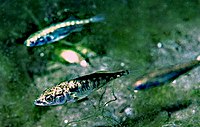
Photo from wikipedia
Abstract Endocrine disrupting chemicals (EDCs) like 17α-ethinylestradiol (EE2) are prevalent in aquatic ecosystems worldwide where they have the ability to decrease fitness by altering the ways in which organisms forage,… Click to show full abstract
Abstract Endocrine disrupting chemicals (EDCs) like 17α-ethinylestradiol (EE2) are prevalent in aquatic ecosystems worldwide where they have the ability to decrease fitness by altering the ways in which organisms forage, court, and react to predators. Boldness serves as a measure of the risks organisms are willing to take to attain resources and is an important, yet underutilized, measure of fitness-related exposure effects. Additionally, the majority of studies on EDC exposure are conducted on freshwater species despite the fact that coastal environments are also at risk. In this study, sexually mature male and female threespine stickleback, Gasterosteus aculeatus, from an anadromous population were placed into one of three treatment groups: control (no EE2), low dose (5 ng/L EE2), or high dose (10 ng/L EE2) to determine if EE2 alters boldness. Fish were tested in four different assays (Shoaling Propensity, Empty Tank, Foraging, and Novel Environment) and their behavior was compared over time and across treatment groups. Changes in behavior were seen after as little as one week of exposure to EE2. Both sex differences and dosage effects were found, with these two variables interacting and contingent upon the assay in which they were examined. In general, females were more affected than males and the higher dose of EE2 had a greater effect than the lower dose. These results indicate that EE2, and likely other EDCs, can generate behavioral changes in organisms in estuarine and marine systems in ways that can negatively influence the fitness of these organisms.
Journal Title: Journal of Experimental Marine Biology and Ecology
Year Published: 2017
Link to full text (if available)
Share on Social Media: Sign Up to like & get
recommendations!